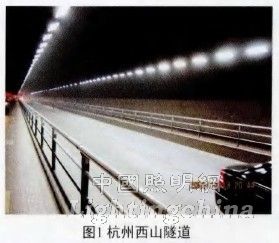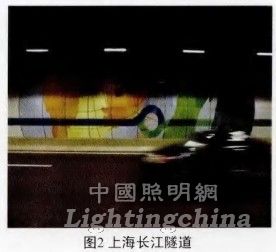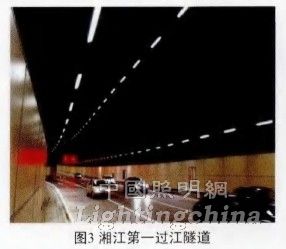Discussion on the innovative application of LED in tunnel lighting
0 Preface
The application of LED in tunnel lighting has been discussed for more than five years. With the development of LED light source and LED lighting technology, the design concept of LED lighting products is coming out of the old way of imitating the appearance of traditional lighting products, lighting construction, optical design, etc., and began to research and apply some innovative designs that reflect the advantages of LED. In terms of outdoor lighting, combined with the characteristics of LED light source and tunnel lighting requirements, the concept of “tunnel continuous light belt illumination†and “tunnel smooth design of tunnel population segmentâ€, which is mainly led by the improvement of tunnel lighting quality and energy saving indicators, has been proposed and Adopted by some large tunnel lighting projects in China, the actual application effect is good. It is expected that these two concepts will become the basic mode of LED lighting in tunnel lighting. This article will introduce and analyze the above two concepts in detail, so that more tunnel lighting can benefit from these two concepts. 1 tunnel continuous light belt lighting concept
The concept of continuous light strip refers to the continuous distribution of the basic illumination source of the tunnel. For example, an LED light source with a power of 0.5 to 1 w/piece is used to fabricate the lamp into a linear illumination lamp, which is installed in the tunnel to realize continuous distribution of the illumination source, thereby constituting continuous light band illumination. The advantage of continuous strip illumination is that the spacing of the lamps is less than a certain interval, so that the uniformity of the road surface in the tunnel is close to 1; the continuous strip illumination without gaps between the lamps can ensure no flicker at any driving speed.
However, due to the consideration of the cost of the lamp, it is impossible to achieve complete continuity in the design and practical application of the basic lighting fixture of the tunnel, but the effect is much better than that of the high-pressure sodium lamp. The actual continuous light with LED tunnel lighting can design the luminaire as a single row or a double row of light source. The length of the luminaire is usually 1~1.5m or 2.4m, so the interval between the basic lighting of the tunnel is better than the traditional lighting. The lamps are much smaller and the driving comfort is also greatly improved. This concept is also fully applicable to the design of tunnel-enhanced lighting fixtures. As much as possible, the width of the reinforced lighting fixtures is reduced, the length is increased, and the interval between the lamps is minimized.
2 The concept of brightness smoothing in the tunnel entrance section
The brightness Lth of the tunnel entrance section can be calculated according to equation (1).

Among them, L20(S) refers to the distance between the starting point of the tunnel and the starting point of the parking section, which is 1.5m above the ground and 20° in the direction of the hole. The average brightness of the measured field is large. You ask: cd/m2;k It is the brightness reduction factor of the inlet section.
For example, suppose the design driving speed is 100km/h, k=0.045, if the outside beam brightness L20(S) is 4000cd/m2, the maintenance factor is 0.75 (the maintenance factor is equivalent to the design brightness of the tunnel entrance section), the tunnel entrance Segment design brightness Lth
= 4000 x 0.045 / 0.75 = 240 cd / m2. Illumination parking line-of-sight Ds=158m, according to JTJ026.1-1999 "Code for Ventilation Lighting Design of Highway Tunnels", the brightness value of excessive 1 segment Lth1=0.3×Lth=72cd/m2, relative to the brightness value of the tunnel entrance segment 240cd/m2 Dropped 70%. When the vehicle travels to the junction of the entrance section and the transition section, a visual black screen effect is formed, which is not conducive to driving safety. The high intensity illumination of the entrance section forms the main energy consumption for tunnel lighting.
In order to improve driving comfort, we propose to gradually reduce the brightness by dividing the entrance segment into 2-3 segments.
Visually, the brightness of the entrance segment and the transition 1 segment are smoothly transitioned. After the brightness of the inlet section is smoothed, the illumination power of the inlet section can be reduced by 25%-30%, which greatly improves the energy saving index of the tunnel illumination.
3 application case
The first tunnel illumination in China using LED continuous light strip lighting concept is the LED lighting renovation of Xishan Tunnel (implemented by Guangdong Guolu Camel Co., Ltd.) in Xiaoshan, Hangzhou. The Xishan Tunnel is a municipal tunnel that was built earlier. The two-lane two-way traffic has a large traffic volume. The original lighting system is a high-pressure sodium lamp. Since the hardware design in the tunnel is not conducive to tunnel lighting, and the existing high-pressure sodium lamp lamps have been used for a long time, the lighting effect in the tunnel is very poor. In order to carry out the lighting renovation, the LED lighting test was carried out on the tunnel in June 2009, and the LED lighting renovation was officially completed in September 2009, and a good lighting effect was achieved (as shown in Figure 1).

After that, the implementation of LED lighting in the Shanghai Yangtze River Tunnel was completed at the end of 2009 (Figure 2). The tunnel has been designed in two ways: the first solution is to use traditional lamp type LED lamps, but its brightness uniformity is not good, and the zebra crossing phenomenon is more serious; later, the continuous light band illumination type is changed, and the lighting effect is greatly improved.

Then, the Qingdao Jiaozhou Bay Submarine Tunnel, the Yantai Golden Roof Tunnel and the Changsha Xiangjiang First Crossing Tunnel LED lighting implementation (Fig. 3) were completed.
